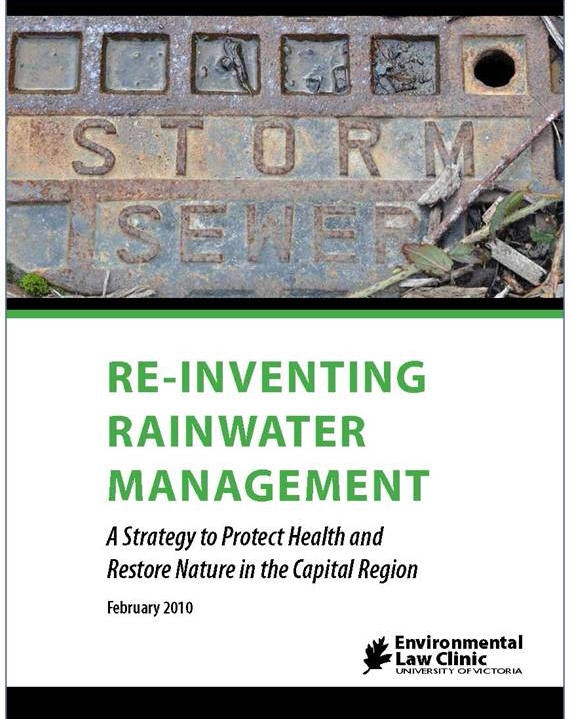Reinventing Rainwater Management: Designing the Green City
Note to Reader:
In December 2012, the Environmental Law Clinic at the University of VIctoria announced the release of Maintaining SuperNatural BC for Our Children: Selected Law Reform Proposals. Organizeds under eight theme areas, this book is a series of 35 short, readable articles – punctuated by photos and cartoons – that describe key environmental law reforms that the authors believe the next provincial government should consider. To download a copy of the book, click here.
“The challenge we face is clear: our rich natural heritage may be lost if we fail to assess and manage cumulative effects”
“Maintaining SuperNatural BC for Our Children is put forward as an educational service to inform the public, government and decision makers about solutions that have been proposed by environmental law experts.  Their recommendations are presented here for public education, debate and consideration – and to trigger law reform ideas from others,” states Calvin Sandborn, editor of the book and the Legal Director of the Environmental Law Clinc.
Their recommendations are presented here for public education, debate and consideration – and to trigger law reform ideas from others,” states Calvin Sandborn, editor of the book and the Legal Director of the Environmental Law Clinc.
“Ultimately, we hope that this book will enrich the discussion about how laws can be changed to better maintain SuperNatural British Columbia for our children.”
 “Calvin Sandborn has the ability to ‘cut to the chase’ and identify core issues. Produced by knowledgeable contributors at the UVIC Environmental Law Centre, ‘Maintaining Super Natural BC for our Children, Selected Law Reform Proposals’ is timely, succinct and invaluable to politicians, professionals and citizens alike,” comments Eric Bonham, a founding member of the Partnership for Water Sustainability in British Columbia.
“Calvin Sandborn has the ability to ‘cut to the chase’ and identify core issues. Produced by knowledgeable contributors at the UVIC Environmental Law Centre, ‘Maintaining Super Natural BC for our Children, Selected Law Reform Proposals’ is timely, succinct and invaluable to politicians, professionals and citizens alike,” comments Eric Bonham, a founding member of the Partnership for Water Sustainability in British Columbia.
Reinventing Rainwater Management: A Strategy to Protect Health and Restore Nature
The Urban Environment is one of the eight theme areas addressed by the book. This theme comprises four articles, including Chapter 20 on Reinventing Rainwater Management: Designing the Green City. This is a synthesis of a document that was released by the Environmental Law Clinic in February 2010 and titled Re-Inventing Rainwater Management: A Strategy to Protect Health and Restore Nature in the Capital Region.
“I appreciate the assistance and collaboration that I received from Waterbucket, and from Kim Stephens in particular, in showcasing our story. Also, Kim helped direct us in a very practical direction, early on in our venture,” reflects Calvin Sandborn.
Paradigm-Shift from STORMwater to RAINwater
“Shakespeare had it right – rain is a gentle blessing that ‘drops from heaven upon the place beneath.’ But we’ve built our cities in a way that turns rainfall into blight. When it rains in our cities, water sweeps over roofs, streets and parking lots, picking up a multitude of pollutants on the urban landscape. Then a network of curbs, gutters and pipes deliver that tainted water at high speed and volume into sensitive water bodies.”
“All the above problems are the legacy of our obsolete 19th century stormwater management system – a system that fails to respect natural systems and water cycles. However, rainwater management practices have recently been developed that make the 21st century Green City possible.”
From Gray to Green Infrastructure
“Re-Inventing Rainwater Management documents how ‘green’ rainwater management has now been adopted by engineers, developers, planners and governments across North America.”
“The report also demonstrates that ‘Design with Nature’ approaches and Low Impact Development techniques are environmentally superior, and often are cheaper. In addition, they can provide incalculable benefits.”
“Modern rainwater management looks at the dynamics of the entire watershed and identifies how development can use ‘green infrastructure’ to restore the function of trees, soil and open space,” concludes Calvin Sandborn.
To Learn More:
To read and download the complete story as published in Chapter 20 of Maintaining SuperNatural BC for Our Children, click on Reinventing Rainwater Management: Designing the Green City.
To download and read Re-Inventing Rainwater Management: A Strategy to Protect Health and Restore Nature in the Capital Region, published in February 2010, click here.
Collaboration with Partnership for Water Sustainability in BC
“In October 2009, when Calvin asked me to comment on the first draft of Re-Inventing Rainwater Management, I was forthright in telling him that it  was not compelling and challenged him to do better. My concern was his over-reliance on examples from the USA, without giving full and proper recognition to the great things that were happening in BC – on the ground and in the local government setting,” recalls Kim Stephens, Executive Director of the Partnership for Water Sustainability in British Columbia
was not compelling and challenged him to do better. My concern was his over-reliance on examples from the USA, without giving full and proper recognition to the great things that were happening in BC – on the ground and in the local government setting,” recalls Kim Stephens, Executive Director of the Partnership for Water Sustainability in British Columbia
“So, I asked Calvin whether he and his team of law students could produce a document that would help us build on what we have collectively accomplished to date in BC. Calvin accepted my challenge and subsequently produced a document that truly resonated. We have been pleased to do our part to draw attention to the importance of Re-Inventing Rainwater Management as a defining document.”
“Re-Inventing Rainwater Management” is a Defining Document
“In February 2010, we invited Calvin to do the formal launch of the document at the Bowker Creek Forum – held at the University of Victoria and co-hosted by the Bowker Creek Initiative and the Partnership. And in the months following, we posted a series of articles on the waterbucket.ca website. Calvin did a great job producing op-ed columns in various newspapers. This made it easy to spread the word.”
“Re-Inventing Rainwater Management is a defining document because it was attention-grabbing and quotable. It got the rainwater management issue on the political radar screen in the Capital Region and that had ripple effects, especially when Calvin Sandborn was invited to tell his story at regional events such as the From Rain to Resource Workshop hosted by the Okanagan Basin Water Board.”
“Posting of a professionally produced video on YouTube also helped to spread the word about Re-Inventing Rainwater Management. One of the featured speakers in the video is the Partnership’s Eric Bonham,” concludes Kim Stephens.
Formal Launch at Bowker Creek Forum
To view Calvin Sandborn provide an overview of Re-Inventing Rainwater Management at the Bowker Creek Forum in February 2010, click here to  access a 5-minute video clip. The Bowker Creek Forum was a celebration of the Bowker Creek Blueprint, a precedent-setting 100-year Action Plan for restoration of the inter-municipal Bowker Creek Watershed in the Capital Region.
access a 5-minute video clip. The Bowker Creek Forum was a celebration of the Bowker Creek Blueprint, a precedent-setting 100-year Action Plan for restoration of the inter-municipal Bowker Creek Watershed in the Capital Region.
This unique multi-jurisdictional effort brought together four local governments (Capital Regional District, City of Victoria, District of Saanich, and City of Oak Bay), community groups, post-secondary institutions and private citizens.
“In the report, we talk about the Bowker Creek Initiative as being an ideal way of approaching (watershed protection and restoration issues). But we need to extend the approach beyond Bowker Creek (to the rest of the Capital Region),” noted Calvin Sandborn.
Stories Posted on Waterbucket
2010-Leading Change: Re-Inventing Rainwater Management in the Capital Region: University of Victoria report urges formation of Capital Regional District Rainwater Commission — “A Regional Commission is necessary to overcome the main barrier to rational rainwater management: the fragmented jurisdiction over runoff in the region. We envision that the new Commission would create a long-term Regional Integrated Watershed Management Plan with a number of mandatory targets,” states Calvin Sandborn.
2010-Vancouver Island Success Stories: Re-Inventing Rainwater Management in the Capital Region: Call for action to implement fundamental changes – — In a presentation to regional politicians, Paddy O’Reilly stressed the need to clean the region’s beaches and work with natural water cycles; and asked the Capital Regional District (CRD) to implement fundamental changes in how the region deals with rainwater and stormwater runoff. brought forward a series of recommendations to the Joint Meeting hosted by the Core Area Liquid Waste Management Committee with the Environmental Sustainability Committee.
— In a presentation to regional politicians, Paddy O’Reilly stressed the need to clean the region’s beaches and work with natural water cycles; and asked the Capital Regional District (CRD) to implement fundamental changes in how the region deals with rainwater and stormwater runoff. brought forward a series of recommendations to the Joint Meeting hosted by the Core Area Liquid Waste Management Committee with the Environmental Sustainability Committee.
 2010-Keep Rain on Site: YouTube Video: ‘Where it falls – Re-inventing rainwater management in British Columbia’s Capital Region’ — “In addition to interviewing several experts and community leaders with knowledge of rainwater and stormwater issues, the film introduces the ELC report that offers a number of innovative solutions, many of which could be applied in the CRD region and beyond,” states Holly Pattison.
2010-Keep Rain on Site: YouTube Video: ‘Where it falls – Re-inventing rainwater management in British Columbia’s Capital Region’ — “In addition to interviewing several experts and community leaders with knowledge of rainwater and stormwater issues, the film introduces the ELC report that offers a number of innovative solutions, many of which could be applied in the CRD region and beyond,” states Holly Pattison.
 2010-Leading Change: Rainwater Revolution: Imagine rain as a resource instead of an urban inconvenience — “The cultural change is actually happening. I think we’re at a tipping point right now in terms of cultural changes. I’m not talking about the entire population obviously. I’m talking about those who have some influence in terms of local government and the way we do business,” said Kim Stephens.
2010-Leading Change: Rainwater Revolution: Imagine rain as a resource instead of an urban inconvenience — “The cultural change is actually happening. I think we’re at a tipping point right now in terms of cultural changes. I’m not talking about the entire population obviously. I’m talking about those who have some influence in terms of local government and the way we do business,” said Kim Stephens.
2010-Success Stories: Re-Inventing Rainwater Management in British Columbia: Rainwater runoff the key to a green city— In an op-ed column published by the Victoria Times-Colonist, Calvin Sandborn of the Environmental Law Clinic at the University of Victoria wrote that “rainwater management practices have recently been developed that make the 21st-century green city possible. Instead of relying heavily on pipes and concrete, this new approach relies upon soil, trees and open space to naturally absorb, store, evaporate and filter rainwater.”
 2010-Leading Change: NEW REPORT LAUNCHED AT BOWKER CREEK FORUM: Re-Inventing Rainwater Management: A Strategy to Protect Health and Restore Nature in the Capital Region — “It was both timely and relevant that on the same day at the Bowker Forum, the UVIC Environmental Law Clinic released Re-Inventing Rainwater Management. The day forced us to ‘think watershed’ and transcend jurisdictional boundaries,” stated Eric Bonham.
2010-Leading Change: NEW REPORT LAUNCHED AT BOWKER CREEK FORUM: Re-Inventing Rainwater Management: A Strategy to Protect Health and Restore Nature in the Capital Region — “It was both timely and relevant that on the same day at the Bowker Forum, the UVIC Environmental Law Clinic released Re-Inventing Rainwater Management. The day forced us to ‘think watershed’ and transcend jurisdictional boundaries,” stated Eric Bonham.
 2010-Leading Change: STORMWATER ROUNDTABLE: Re-Inventing Rainwater Management: A Strategy to Protect Health and Restore Nature in the Capital Region — “These new ‘smart’ rainwater management practices can solve the problems associated with urban stormwater runoff. The green revolution in rainwater management gives us pragmatic and cost-effective ways to make a better community for our grandchildren,” states Deborah Curran.
2010-Leading Change: STORMWATER ROUNDTABLE: Re-Inventing Rainwater Management: A Strategy to Protect Health and Restore Nature in the Capital Region — “These new ‘smart’ rainwater management practices can solve the problems associated with urban stormwater runoff. The green revolution in rainwater management gives us pragmatic and cost-effective ways to make a better community for our grandchildren,” states Deborah Curran.
2010-Success Stories: Re-Inventing Rainwater Management in the Capital Region: The pollution problem we can’t save for a rainy day — “Modern rainwater management looks at the dynamics of the entire watershed and identifies how development can use ‘green infrastructure’ to maintain natural systems and protect buildings. It works to restore the function of trees, soil and open space,” says Calvin Sandborn.




